Ready to step into the exciting world of microgreens?
If yes, you know that it’s not just about veggies but it’s about little plants packed with nutrition and taste. It also serves as a lucrative business opportunity.
However, starting a microgreens business demands more than just growing stuff; it needs careful planning and preparation. Surprisingly, a well-thought-out business plan will surely help you with that!
Well, we understand that drafting a detailed business plan may seem challenging. That’s why we are here with our microgreens business plan template.
It will simplify your business planning process and assist you in outlining your goals and strategies to kickstart a successful microgreens business.
So, let’s jump in together and discover the secrets to crafting a microgreens business plan.
Why You Need a Microgreens Business Plan
A business plan is not just a document; it’s a foundation for planning, managing, and growing a microgreens business. It serves as the strategic roadmap that confidently navigates you to a successful venture.
Whether you’re an experienced farmer or a beginner, a well-written business plan can be essential to thrive in the competitive marketplace.
Here are some benefits you should know:
Outline strategies
An actionable business plan helps you outline your microgreens business goals, core values, and strategies you’ll use to achieve success. It also provides a detailed analysis of your target market, marketing efforts, pricing strategies, and business operations.
Secure funding
A professional business plan can also help you secure funding or capital investment for your microgreens business. It includes detailed financial projections that indicate how much money you need or expect to make over a period.
Identify potential challenges and opportunities
With the help of a well-crafted business plan, you can identify potential challenges and opportunities before they arise. It helps you anticipate possible obstacles in the microgreens market and develop contingency plans.
Keep you on track
A detailed microgreens business plan helps you stay focused and responsible as you start and grow your business. It keeps you focused on your goals and helps you make informed decisions that align with your vision and mission.
So, having a comprehensive business plan can be the key to success in this ever-evolving market landscape.
Making the necessary preparations for Microgreen’s business plan
Before diving right into how to write a business plan, let’s make a strong foundation for writing a successful microgreens business plan.
Here are some crucial aspects to grasp before putting pen to paper:
Knowing your market
Before starting your microgreens company, it’s crucial to analyze the market. Specifying potential customers and their preferences will offer you a clear idea of current trends, significant demand, and potential growth.
Determining startup costs
Once you have recognized the microgreens market demand, it’s time to estimate the startup costs. It includes equipment, seeds, soil, and marketing expenses. Also, consider other necessary resources for growing microgreens indoors or outdoors.
Making a financial budget
After deciding on startup costs, make a financial budget for your microgreens business. It incorporates all the payments such as rent/mortgage, utility bills, insurance fees, taxes, and labor costs. Ensure that all the expenses stay within your budget.
Understanding cultivation techniques
It’s important to familiarize yourself with the microgreen growing process. Understand the optimal conditions for microgreens growth and clearly define the environmental impact of those methods and packaging materials.
Developing marketing strategy
Creating a marketing plan(including online and offline strategies) is essential to promote your microgreens business effectively. You can explore branding opportunities and collaborate with farmers’ markets, restaurants, and grocery stores.
Now you’ll be well-equipped to draft a professional microgreens business plan. So, without further ado; let’s get started.
How to Write a Microgreens Business Plan (w/ examples)
- Draft an Engaging Executive Summary
- Provide a Company Overview
- Incorporate Your Industry and Market Analysis
- List Your Products and Service Offerings
- Pricing Your Microgreen Products
- Prepare a Marketing Plan
- Introduce Your Team
- Outlay Your Operations Plan
- Prepare Financial Projections
- Track and Update Your Plan
1. Draft an Engaging Executive Summary
An executive summary is the first section of your plan, providing the high-level overview of the entire microgreens business plan.
Usually, it is written in the end once the whole business plan is ready. This is so because it summarizes the most important points mentioned in your plan.
Your executive summary may include your business idea, core values, objectives, success factors, and details about your financials.
So, start this section with a quick introduction to your microgreens business, including owners, business name, location, and what type of business you are operating.
Have a look at Super Sprouts’ business introduction written using Upmetrics AI Assistant:
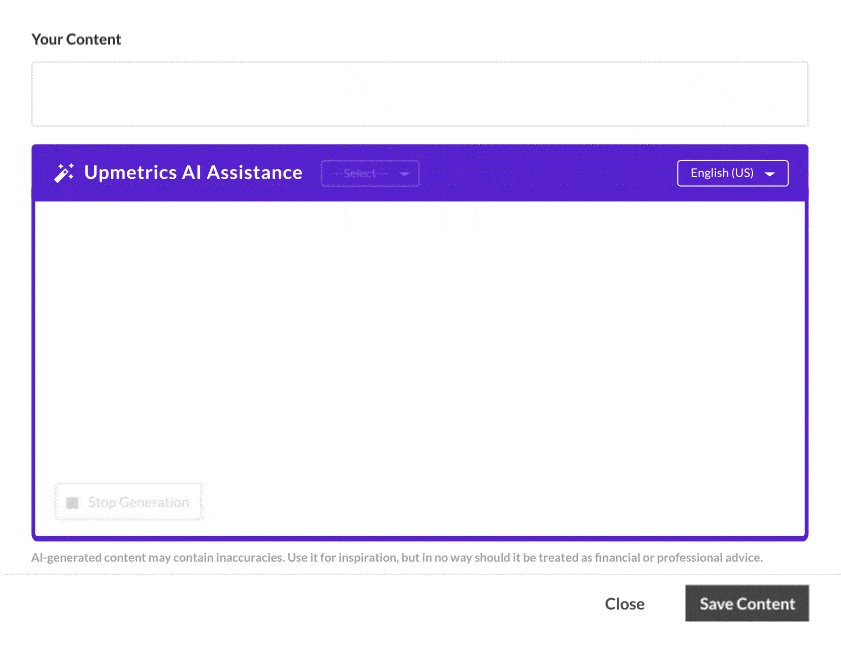
Next, briefly discuss the microgreens industry, market opportunity, and business objectives. Also, highlight your management team, key success factors, and financial projections.
Conclude this section with a clear call to action, inviting potential investors or readers to discuss more about your business or investment.
Note that investors or readers may not read your entire business plan, but they will surely go through the executive summary. So, ensure that you keep it simple, crisp, and engaging.
Say goodbye to boring templates
Build your business plan faster and easier with AI
Plans starting from $14/month

2. Provide a Company Overview
The company overview section provides detailed information about your business. It includes company name, owners, legal structure, location, business history, and everything about your business.
As you will provide a quick company overview in the executive summary, this chapter will expand on it, giving an in-depth understanding of your microgreens business.
First, you may provide the basic details of your microgreens company, such as what is name, legal structure, and what type of business you own.
For instance, there are the primary types of microgreens business:
- Organic Microgreens
- Hydroponic Microgreens
- Soil-Grown Microgreens
After that, mention your business background or startup history(if any) and the milestones you have achieved. Also, add a memorable, clear mission statement for your business.
Describe short-term and long-term business goals in this section. Here’s an example of business objectives written for a Super Sprouts business:
Short-term(1 -3 Years) goals:
- To begin commercial operations in Jacksonville by Q1 2025
- To build a wide range of plants, bulbs, and flowers to meet the increasing market requirement for organic produce
- To achieve a minimum of 10% growth in revenue annually
Long-term(3-5 years) goals:
- To gain a competitive edge within the country’s microgreens industry marketplace by establishing a brand that is synonymous with locally grown and organic
- To explore GM of plants and how a variety of customization in crops can be achieved
- To build a market reputation for superior networks, efficient services, and reliable delivery timelines during the forecast period.
- To leverage the company’s position in Florida to expand operations beyond the state to envelope regions across North America during the forecast period.
3. Incorporate Your Industry and Market Analysis
The market analysis section is a breakdown of your external business environment, providing a deep understanding of the specific industries or sectors in which your business operates.
It provides valuable insights into the market and helps you to identify the untapped areas to stand out from your competitors.
This chapter helps your readers or potential investors to understand the broader microgreens industry, target customers, emerging trends, potential challenges, and opportunities.
So, you’ll require thorough industry research and analytical work for a successful microgreens business.
Here are certain key factors to include in your microgreens business plan:
Market size and growth potential
Provide a comprehensive overview of your microgreens industry analysis. Consider market growth factors and financing availability to analyze the potential market share.
As a microgreens business owner, you know that microgreens are becoming increasingly prevalent among health-conscious people due to their high nutritional value and unique taste profiles.
The microgreens industry had a remarkable surge in popularity, and the market size is estimated at $245.77 billion in 2024. This is expected to reach $335.16 billion by 2029.
Target market
In this section, you may give details of the target market you serve or expect to serve.
Conduct thorough market research and identify your target customers. This will help you ensure that you cater to the right customers.
Try to determine the customer segment or specific group of people who want to purchase microgreens from you. For instance,
- Consumers who prioritize health and nutrition, seek out nutrient-rich microgreens
- Farmers’ local markets or local grocery stores if they sell fresh micro greens.
- Specialty food stores, restaurants, and grocery stores that need a regular supply of locally-grown produce.
Create a buyer’s persona by exploring the psychographic and demographic details of the ideal customer. Navigate their preferences and buying habits to customize your strategies that align with market demands.
You may refer to the below example showing the buyer persona for a Super Sprouts business:

Conduct online surveys or interviews with potential customers to gather their needs and preferences.
Competitor research
Now, it’s time to identify the top competitors in the microgreens businesses. Get details of your direct & indirect competitors in the local market.
Direct competitors can be other microgreens businesses, while plant nurseries can be your indirect competitors. Analyze their microgreens businesses to define their strengths & weaknesses.
A better way to conduct this analysis is by seeing things from a customer’s viewpoint. You might even seek feedback directly from your competitors’ customers and get valuable insights into their preferences.
It is a very important aspect of market research that helps you evaluate the competitive landscape and determine what sets your microgreens business apart.
Explain your competitive advantage and show potential stakeholders that your microgreens company is ready to thrive.
You may also conduct a SWOT analysis to easily identify your internal strengths & weaknesses and external opportunities & threats in the industry. For instance,

Market trends
This section covers the prominent industry trends affecting the microgreens market. For instance, there is a rising demand for indoor farming, sustainable practices, and locally sourced microgreens.
4. List Your Products and Service Offerings
In the products and service offering section, you may consider sharing details of your product or service range, description, benefits, and more.
You may include different varieties of microgreens available and prefer the ones that align with your business goals and target market. Besides that, mention delivery services, wholesaling, or any other services.
Start by describing the nutritious microgreens you will be offering, such as arugula, broccoli, collards, kale, peas, radish, wheatgrass, sunflower, beets, red cabbage, or immunity booster fruits & vegetables.
Highlight its health benefits that appeal to health-conscious consumers. Take the below as a reference to craft your offerings:
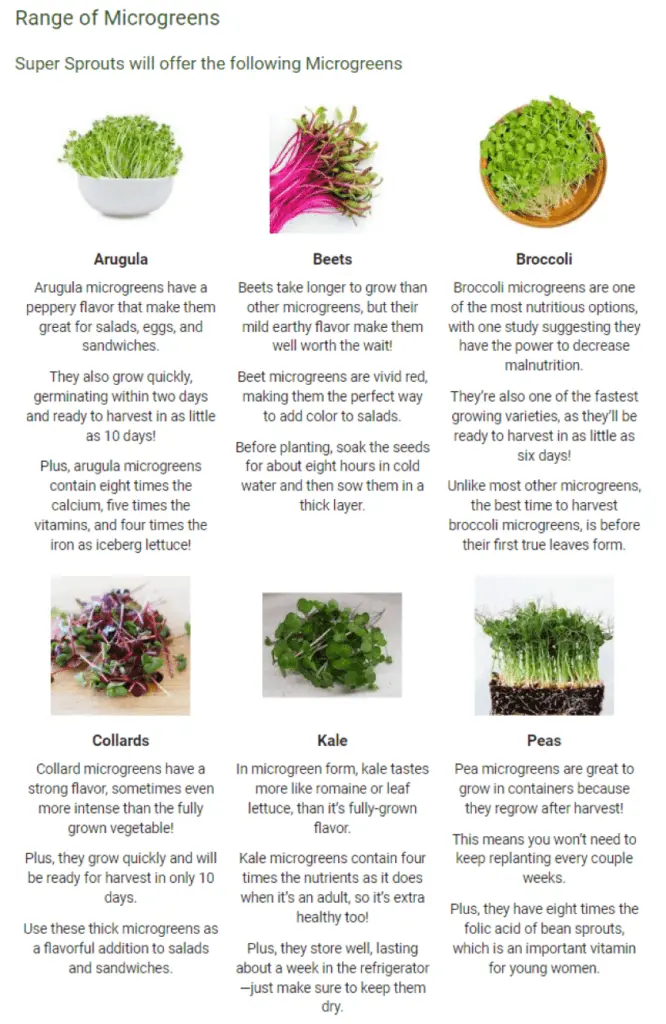
Don’t forget to add microgreen products’ unique flavors, colors, and textures, which make them a versatile ingredient for local chefs and home cooks.
5. Pricing Your Microgreen Products
This section can be an important part of your plan while searching for an investor or partner, as well-articulated product prices can help you persuade them.
So, you should consider a few factors when documenting prices for your microgreens, such as production costs and market prices.
Production cost includes all the expenses of the microgreens production process, including seeds, soil, water supply, electricity, and labor.
You may research market prices of similar microgreen products in your area or online. Get an idea of the target market’s preferences. Are they(health-conscious individuals or high-end restaurants) willing to pay premium prices for organic and locally sourced microgreens?
Don’t forget to include packaging and transportation costs in your pricing if you are selling microgreens online and delivering them to customers.
By estimating all these aspects, you may determine a minimum price or perceived value for your microgreens that covers your costs and assures profitability.
You may also offer discounts for bulk orders and regularly adjust prices to encourage customers to buy from you. Doing so can increase your sales volume and revenue.
Here is a written example; illustrating a pricing strategy for a microgreens business:
Super Sprouts will trade a range of microgreens. The direct cost is primarily attributable to the procurement cost of the produce plus transportation.
Our pricing strategy aims to provide affordability without compromising on quality standards, starting at $3 per tray.
This will allow the company to earn a margin of around 20% on each variety of microgreens.
6. Prepare a Marketing Plan
Your business’s sales and marketing plan decides how your products are displayed and reach your target audience.
A well-crafted marketing plan can help you develop effective campaigns and streamline your marketing efforts while keeping track of the marketing budget and maximizing return on investment.
You may discuss a list of sales strategies and promotional techniques to draw new customers and retain existing ones for your microgreens business.
Consider including the below information in your marketing strategies:
Unique Selling Proposition(USPs)
You may specify your unique selling points to differentiate your microgreens company. Consider including custom microgreens blends that cater to distinctive flavor profiles or nutritional needs.
Online Advertising
Use online platforms such as social media channels, email marketing, and professional branding to target particular audiences and build trust among them. Generate visual ads and content to showcase all your offerings.
To write this subsection, you may refer below example written using our AI assistance feature:
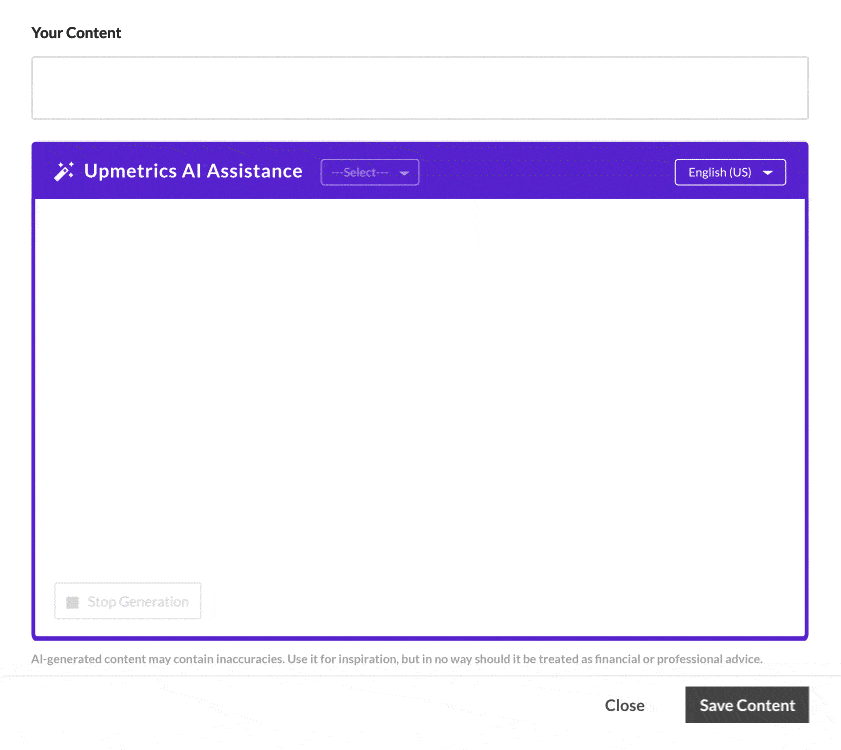
Networking and events
Attend local farmers’ markets and participate in exhibitions or events to display a range of flavorful microgreens and disseminate flyers. This will give you a chance to answer queries and create a sense of urgency.
Partnerships
You may partner with local restaurants and grocery stores to expand your product offerings and reach a wider audience. This can increase your brand’s visibility and growth opportunities.
Discounts or rewards
Providing discounts helps you attract new customers and retain existing ones. So, try to offer discounts on the first purchase for new consumers or introduce a loyalty program to reward frequent shoppers.
7. Introduce Your Team
Your management team is crucial for the ultimate success of your business. This section emphasizes your owners and management team, along with their roles & responsibilities, educational background, industry experience, and compensation plan.
A powerful management team section can be essential to weigh authority and help investors to be confident about your business idea and vision.
For your microgreens business, you may introduce your key members, including horticulturists, marketing experts, culinary enthusiasts, etc. And mention their qualifications, experience, and skills.
Ensure that you communicate their achievements and contributions to sustainable agriculture practices.
Also, describe the compensation plan that includes salaries, incentives, or employee benefits.
If your team is lacking, mention advisory board members with experience in handling microgreens operations or successfully driving small businesses.
8. Outlay Your Operations Plan
The operational plan outlines all the details of everyday business operations and activities centered on achieving the business objectives and goals that you have mentioned in the earlier sections.
So, the Microgreens operations plan helps you and your team define responsibilities and daily tasks. And doing so can help you keep track of your future business goals.
You may summarize the cultivation process, harvesting, packaging, sourcing, distribution, staffing, and customer service in this section. Highlight how it directly impacts the quality of services and pique the reader’s interest.
Let’s explore key elements your operations plan section must include:
Staffing
Start by introducing your devoted team and their roles for seamless business operations. Also, mention your microgreens company’s hiring plan and explain training programs to foster a skilled workforce.
Here is an illustration of a staffing requirement with the help of Upmetrics:
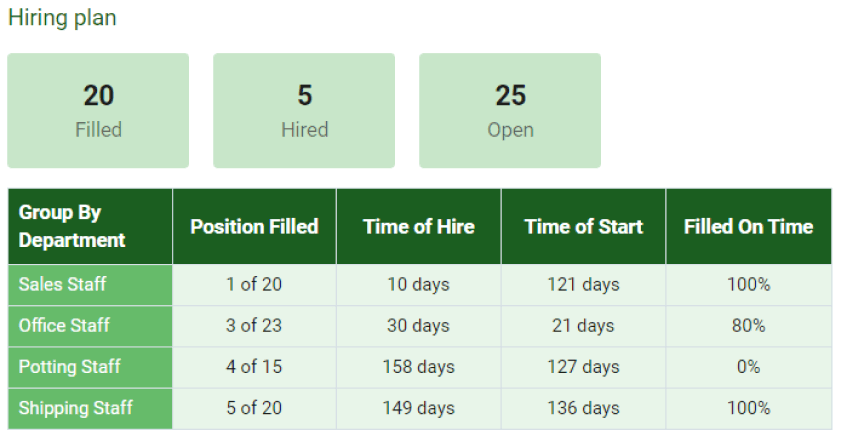
Operational process
Detail the intricacies of your supply chain, sourcing processes, farming techniques, managing inventory, and tracking orders. Also, find reliable suppliers for seeds, soil, and other materials. Ensure you provide consistent quality and timely delivery of fresh microgreens.
Equipment/Technology
Describe the equipment or technology you use to streamline operations and create an ideal condition for microgreen growth.
You may include growing trays or containers, growing mediums, harvesting/irrigation tools, packaging materials, and lighting systems.
Also, consider technology commonly used in microgreens business, such as drones or UAVs (Unmanned Aerial Vehicles), climate control systems, inventory management software, and monitoring systems.
9. Prepare Financial Projections
A well-structured and in-depth financial plan comes last in the Microgreens business plan but is the most exciting section for potential investors.
It is a detailed blueprint of all the cash flow and revenue projections, initial startup costs, and how these expenses will be covered through the profit margins.
This financial plan has a significant value in terms of whether you secure funding or not. So, mention all the below key factors in your plan:
Income statement
An income statement is typically known as a profit and loss statement, or P&L, displaying your earnings and then deducting your operating costs to ascertain whether you made a profit or not.
So, create a projected profit & loss statement that shows the expected revenue, cost of product/services sold, and operational expenses. From that, you can estimate the business’s anticipated net profit or loss.
Here is an example of a projected income statement with the help of Upmetrics:
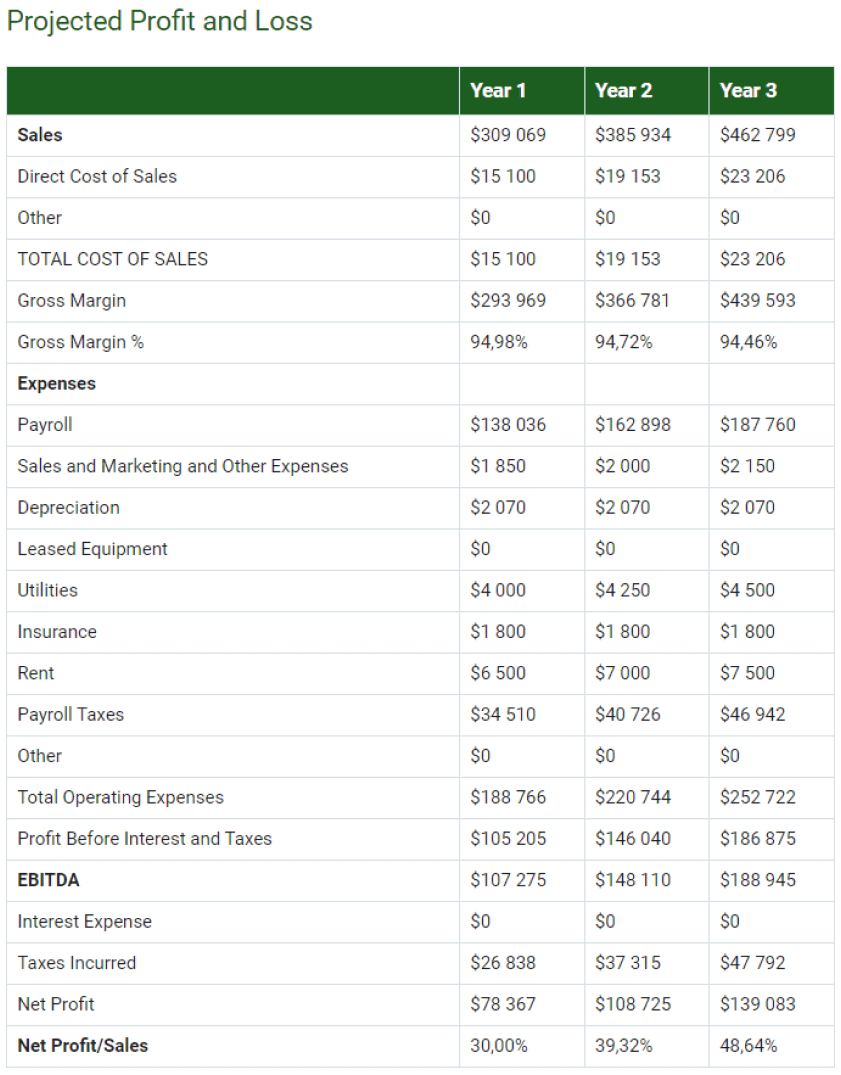
Balance sheet
A balance sheet indicates your assets and liabilities. Although it can include a lot of details, like equity, goodwill, or other intangible assets. You can create a prospective balance sheet at the end of the first year.
Cash flow statement
Your cash flow statement helps you notice how much money you require to start or grow your microgreens company and avoid running out of money.
Surprisingly, you can earn a profit but still encounter financial problems that could lead to bankruptcy. Therefore, you will need appropriate cash flow planning to avoid such circumstances.
From the above financial statements, identify the funding needs and evaluate the funding resources for your microgreens company, including bank loans, SBA-guaranteed loans, real estate investors, or personal savings.
10. Track and Update Your Plan
Finally, it’s very crucial to regularly track and update your plan based on all the aspects of your result analysis. This can help you refine your business strategies over time.
According to your results, you can adjust your product offerings, make informed decisions, capitalize on strengths, and address weaknesses.
Actively engaging in this procedure can help you find what works best for your microgreens business and which specific approaches are more effective than others.
So, keep a sharp eye on your business metrics and thrive in the competitive landscape.
Download Free Microgreens Business Plan Template
Need help writing a microgreens business plan from scratch? Well, here you go; download our free microgreens business plan pdf now and get started.
This modern business plan template is specially designed for your microgreens business. It provides step-by-step instructions and examples to help in writing your own business plan.
The Quickest Way to turn a Business Idea into a Business Plan
Fill-in-the-blanks and automatic financials make it easy.
Make Investment-ready Plans in Minutes With AI
Now, let’s simplify the entire business planning process with our business planning software—Upmetrics. We provide step-by-step guides, 400+ sample business plans, and AI support to make an actionable business plan in easy steps.
Also, our financial forecasting tool will help you create accurate financial projections for 3 years or more if you are not great at finances.
Whether you are aiming to start your own business or grow an existing one, we offer valuable resources to write successful and professional business plans.
So, don’t wait and get started now!




![Download Microgreens Business Plan Template & Guide [Updated]](https://static-web.upmetrics.co/wp-content/uploads/2023/10/12100247/business-plan-template.png)